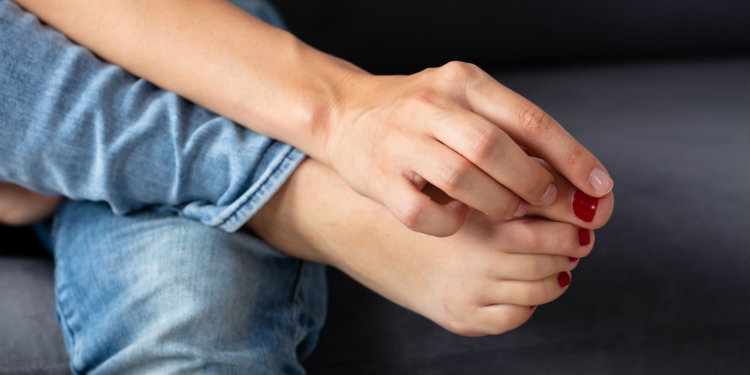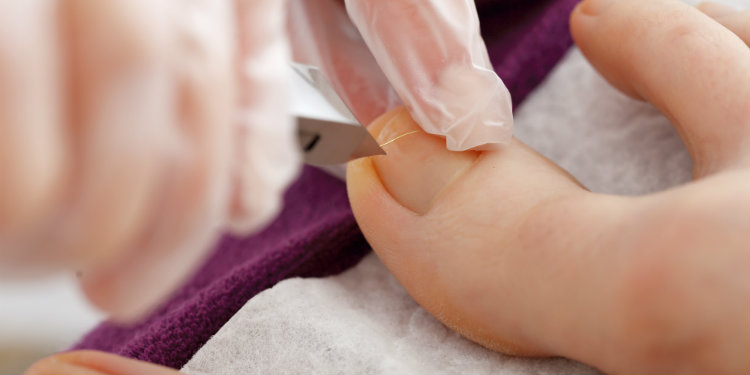Why Do Ingrown Toenails Happen?
Understanding the root cause of a problem—and an ingrown toenail definitely qualifies as a problem—is a key for not only being able to resolve it, but also prevent it from happening in the first place.
We’ve previously discussed how we can treat a toenail that has become ingrown.
Today, let’s focus more on why this problem can develop, signs you should recognize, and recap some ingrown toenail prevention measures you can take. Hopefully, in doing so you will have the tools to avoid having this condition develop.
Before we dive into this, a quick reminder:
If you are suffering from pain caused by an ingrown toenail and basic at-home care isn’t providing the results you want, come see us. We’ve been able to help many other neighbors from across our greater Milwaukee community—and we can do the same for you!
Alright, having gotten that out of the way, how did you end up with an ingrown toenail?

What causes ingrown toenails?
Well, there are a couple of possible answers to this question. Depending on your specific case, it may have been a matter of:
- How you trim your nails. Sometimes, toenails become ingrown when they are clipped too short and/or are rounded off.
- The shoes you wear. There are many reasons why you and your loved ones should have footwear that actually fits correctly—and this is one of them. Some cases of ingrown toenails are caused by shoes that are too tight in the front.
- Physical trauma. No matter if the trauma comes from something heavy being dropped on a foot or when a toe is stubbed with great force, one possible outcome is an ingrown toenail.
- Unfortunately, an inherited nail or foot structure can come into play, particularly if a toenail is excessively curved.
Now, if you take a moment to think about those respective factors, it’s probably easy to see that this is a problem that can happen to virtually anyone. Whereas some other foot issues tend to be more prevalent in specific demographics—bunions are more prominent in females, osteoarthritis is most commonly seen in older patients, etc.—this condition only requires that you have toenails.
In fact, sometimes even infants as young as two-months-old can have ingrown nails!
Keeping that in mind, an important question then becomes:
How do you recognize an ingrown nail?
What are ingrown toenail signs and symptoms?
With regards to the symptoms of ingrown toenails, the best starting point is with the simple fact one of your nails has grown into the skin flanking it.
Because there is now something digging into your skin, you will likely experience at least a certain degree of discomfort and pain. If you don’t, this could potentially be an indication of a peripheral neuropathy issue—and especially if you have diabetes.
(Remember, if you are one of the almost 30 million Americans who have that disease, it is essential that you practice responsible diabetic foot care!)
Along with the pain and discomfort, the area will usually become red, swollen, and tender to the touch.
Since you have an open pathway into your warm body for microorganisms (such as fungi, bacteria, and viruses), you have an increased risk for infection. With that being the case, it is important that you monitor the situation and be aware of signs of infection (fever, pus, spreading redness).
In the event you have contracted an infection, it is essential for you to see us ASAP. We can prescribe appropriate medication to clear it up for you.
If you are diabetic and observe signs of infection, seek immediate medical attention.
Most people would agree that symptoms like those are less than desirable, so what can you do to prevent this problem from developing?

How can you prevent ingrown toenails?
For ingrown toenails caused by something other than “genetics,” some measures you can take to lower your risk include:
- Follow proper nail trimming practices. As you might have gathered from the fact that “too short and rounded” is bad, the best way to trim your toenails is straight across and at an appropriate length (which is roughly even with the edge of the respective toes).
- Wear shoes that fit correctly. Shoe fit is a more important consideration than most people realize (until they start to experience problems or issues like this). So what does it mean for a shoe to fit well? Basically, you want your footwear to have a snug fit, but not be excessively tight. And that is especially true in the toe box (front), where you want there to be enough room so toes can wiggle freely. Also, there should be about a thumb’s width between the longest toe and front of a shoe.
- Protect your feet at work. If your job requires you to move heavy items on a frequent basis or be in an environment where there’s a high risk things could fall on your feet, you should invest in a pair of safety shoes or steel-toed work boots. (The good news is that many employers will make this a requirement when circumstances like those are present.) When you do, make sure you adhere to the following tip!
- Ask for help. If you are going to move something heavy at home, ask a loved one or friend to help you. Sure, this will reduce your risk of having the object fall on your foot and causing an ingrown toenail, but it can also help you prevent a plethora of other possible injuries as well.
Speaking of asking for help, seeking professional treatment when you have severe pain or a recurrent condition is a smart move.
In fact, if the root cause for your ingrown nail is related to inherited structure, you will most likely keep having the same problem over and over again without appropriate intervention. To this end, the best course of action will likely be removing the repeat offender on a permanent basis.
Milwaukee County’s #1 Choice for Ingrown Toenail Treatment!
There are measures you can take on your own to relieve symptoms and improve the condition, but sometimes you simply need professional care. As we’ve noted, this is especially true in cases that are severe or recurrent—and when diabetes is also in the picture!
At Wisconsin Foot Center, we are proud to help residents from across our Southeast Wisconsin community find relief from all manners of lower limb problems, including ingrown toenails. If you are suffering or unable to perform your normal activities, please feel free to contact our Hales Corners office by calling (414) 425-8400 or take advantage of our online form and request your appointment.
Request an Appointment
© Wisconsin Foot Center. All Rights Reserved. Website & Marketing By Podiatry Growth

